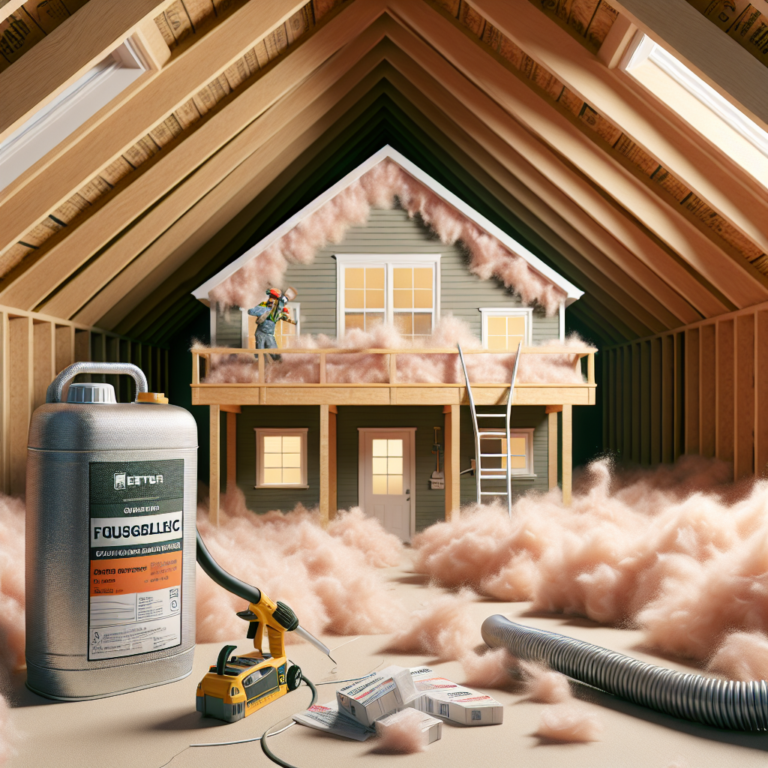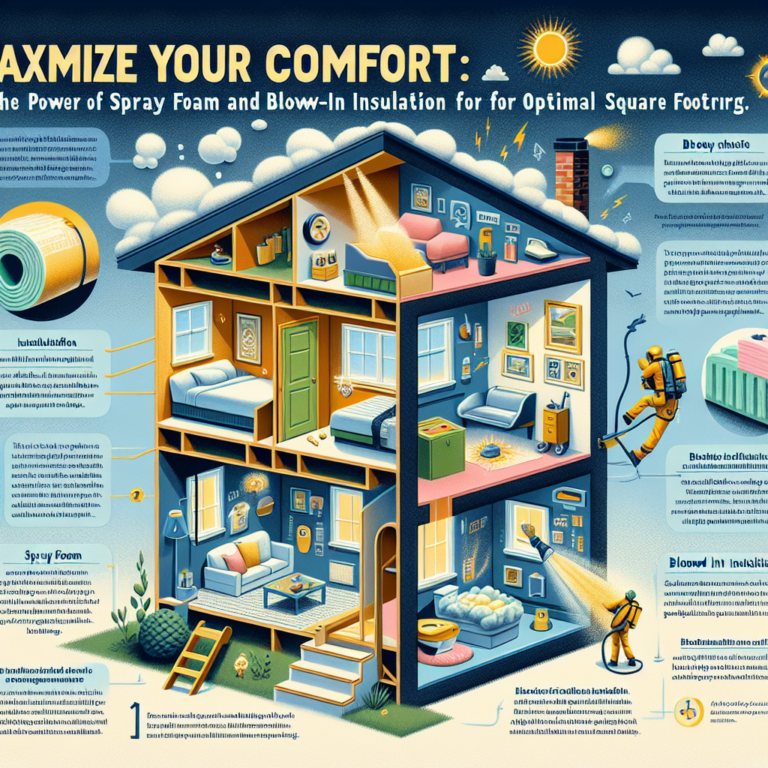-
Table of Contents
Insulate with ease, choose blown-in over spray foam!
Introduction
Blown-in insulation and spray foam are two popular methods of insulating homes and buildings. While both are effective in reducing energy costs and improving indoor comfort, they have distinct differences in terms of installation, cost, and performance. In this article, we will focus on blown-in insulation over spray foam and discuss its benefits and drawbacks.
Benefits of Blown Loft Insulation Over Spray Foam
blown loft insulation and spray foam are two popular options for insulating homes and buildings. Both have their own unique benefits and drawbacks, but in recent years, blown loft insulation has gained popularity over spray foam. In this article, we will explore the benefits of blown loft insulation over spray foam and why it may be the better choice for your insulation needs.
First and foremost, blown loft insulation is a more cost-effective option compared to spray foam. The installation process for blown insulation is much simpler and requires less labor, resulting in lower installation costs. Additionally, blown insulation is typically made from recycled materials, making it an environmentally friendly choice. On the other hand, spray foam is made from chemicals and can be more expensive to install due to the specialized equipment and expertise required.
Another advantage of blown loft insulation is its ability to cover hard-to-reach areas. The insulation is blown into the space using a machine, allowing it to fill in any gaps or crevices that may be missed by other types of insulation. This makes it a great option for older homes or buildings with irregularly shaped attics or walls. Spray foam, on the other hand, is applied as a liquid and expands to fill the space. While this can also cover hard-to-reach areas, it may not be as effective in filling in small gaps or cracks.
One of the main benefits of blown loft insulation over spray foam is its ability to be easily removed and replaced. If you need to access the space behind the insulation for any reason, blown insulation can be easily vacuumed out and replaced after the work is done. This is not the case with spray foam, which can be difficult and messy to remove. This makes blown insulation a more practical choice for areas that may require frequent access, such as attics or crawl spaces.
In terms of energy efficiency, both blown loft insulation and spray foam are effective in reducing heat loss and improving energy efficiency. However, blown insulation has a higher R-value (a measure of thermal resistance) compared to spray foam. This means that blown insulation can provide better insulation and energy savings in the long run. Additionally, blown insulation is less prone to settling over time, ensuring that it maintains its effectiveness for years to come.
Another advantage of blown loft insulation is its ability to reduce noise transmission. The loose fibers of the insulation act as a sound barrier, absorbing and reducing noise from outside or between rooms. This can be especially beneficial for homes or buildings located in noisy areas or for those who value privacy and quietness.
Lastly, blown loft insulation is a safer option compared to spray foam. Spray foam can release harmful chemicals during installation and may require occupants to vacate the premises for a period of time. Blown insulation, on the other hand, is made from natural materials and does not pose any health risks. This makes it a more suitable option for families with children or individuals with respiratory issues.
In conclusion, while both blown loft insulation and spray foam have their own benefits, blown insulation has emerged as the preferred choice for many homeowners and builders. Its cost-effectiveness, ability to cover hard-to-reach areas, ease of removal and replacement, higher R-value, noise reduction, and safety make it a practical and efficient option for insulating homes and buildings. If you are considering insulation options for your property, be sure to weigh the benefits of blown loft insulation over spray foam and make an informed decision based on your specific needs and budget.
Cost Comparison: Blown Loft Insulation vs. Spray Foam

When it comes to insulating your home, there are many options available in the market. Two popular choices are blown loft insulation and spray foam insulation. Both of these methods have their own advantages and disadvantages, but one factor that often plays a major role in decision making is the cost. In this article, we will compare the cost of blown loft insulation and spray foam insulation to help you make an informed decision.
blown loft insulation, also known as blown-in insulation, is a method where loose insulation material is blown into the attic or loft space using a special machine. This material can be made of fiberglass, cellulose, or mineral wool. On the other hand, spray foam insulation is a liquid foam that is sprayed onto the walls, floors, and ceilings of a building. It expands and hardens, creating a barrier against heat loss. Both of these methods are effective in reducing energy costs and improving the overall comfort of your home. However, the cost of installation and materials can vary significantly.
The cost of blown loft insulation is relatively lower compared to spray foam insulation. The average cost of blown loft insulation is around $1.50 to $3.50 per square foot, depending on the type of material used and the thickness of the insulation. This means that for a 1,000 square foot attic, the cost of blown loft insulation would be between $1,500 to $3,500. This cost includes the labor charges as well. On the other hand, the average cost of spray foam insulation is around $2.00 to $6.00 per square foot. This means that for the same 1,000 square foot attic, the cost of spray foam insulation would be between $2,000 to $6,000. This cost also includes the labor charges.
One of the reasons for the higher cost of spray foam insulation is the specialized equipment and training required for installation. The liquid foam needs to be sprayed evenly and in the right thickness to ensure maximum effectiveness. This requires the use of expensive equipment and trained professionals, which adds to the overall cost. On the other hand, blown loft insulation can be installed using a simple machine, and the process is relatively easier and quicker. This reduces the labor cost and, in turn, the overall cost of installation.
Another factor that affects the cost of insulation is the R-value. R-value is a measure of the insulation’s ability to resist heat flow. The higher the R-value, the better the insulation. Spray foam insulation has a higher R-value compared to blown loft insulation. This means that to achieve the same level of insulation, you would need a thicker layer of blown loft insulation, which would increase the cost. However, it is important to note that the R-value of blown loft insulation can be increased by adding more layers, which can be a cost-effective option.
Apart from the initial cost of installation, it is also important to consider the long-term cost of insulation. Spray foam insulation has a longer lifespan compared to blown loft insulation. It can last up to 80 years, while blown loft insulation may need to be replaced after 20-30 years. This means that in the long run, spray foam insulation may be a more cost-effective option as it would not require frequent replacements.
In conclusion, the cost of insulation depends on various factors such as the type of material, R-value, and lifespan. While blown loft insulation may have a lower initial cost, spray foam insulation may be a more cost-effective option in the long run. It is important to consider your budget, energy efficiency goals, and the specific needs of your home before making a decision. Consulting with a professional insulation contractor can also help you determine the best option for your home. Ultimately, the right insulation choice will not only save you money but also improve the comfort and energy efficiency of your home.
Environmental Impact: Blown Loft Insulation vs. Spray Foam
Blown in insulation and spray foam are two popular options for insulating homes and buildings. Both methods have their own advantages and disadvantages, but one aspect that is often overlooked is their environmental impact. In this article, we will compare the environmental impact of blown in insulation and spray foam, specifically in terms of their production, installation, and disposal.
Production:
Blown in insulation is typically made from recycled materials such as paper, cellulose, or fiberglass. These materials are readily available and do not require a lot of energy to produce. On the other hand, spray foam is made from petrochemicals, which are non-renewable resources. The production of spray foam requires a significant amount of energy and emits greenhouse gases, contributing to climate change.
Installation:
Blown in insulation is installed by blowing loose fibers or particles into the desired space, filling in any gaps and creating a barrier against heat transfer. This method does not require any special equipment and can be done quickly and easily. In contrast, spray foam requires specialized equipment and trained professionals to install it. The process involves mixing chemicals on-site, which can release harmful fumes into the environment. Additionally, the equipment used for spray foam installation consumes a large amount of energy, further adding to its environmental impact.
Disposal:
When it comes to disposal, blown in insulation has a clear advantage. As it is made from recycled materials, it can be easily recycled again or safely disposed of in landfills. On the other hand, spray foam cannot be recycled and must be disposed of in a special facility. This process can be costly and has the potential to release harmful chemicals into the environment if not done properly.
Environmental Benefits:
In terms of environmental benefits, blown in insulation has several advantages over spray foam. As mentioned earlier, it is made from recycled materials, reducing the need for new resources. It also has a lower carbon footprint compared to spray foam, as it does not require as much energy to produce and install. Additionally, blown in insulation is known for its ability to reduce energy consumption and lower utility bills, making it a more sustainable choice in the long run.
Environmental Concerns:
While blown in insulation has its environmental benefits, it also has some concerns. The production of fiberglass insulation, a common material used in blown in insulation, can release harmful particles into the air. These particles can cause respiratory issues and contribute to air pollution. However, this can be mitigated by using alternative materials such as cellulose or recycled denim.
On the other hand, spray foam has its own set of environmental concerns. The chemicals used in its production and installation can release volatile organic compounds (VOCs) into the air, which can be harmful to both human health and the environment. Additionally, spray foam has a higher embodied energy, meaning it requires more energy to produce and has a larger carbon footprint compared to blown in insulation.
In conclusion, both blown in insulation and spray foam have their own environmental impacts. While blown in insulation has a lower carbon footprint and is made from recycled materials, it can still have concerns with the production of certain materials. On the other hand, spray foam has a higher embodied energy and can release harmful chemicals into the environment. Ultimately, the choice between these two methods should be based on a thorough consideration of their environmental impact, as well as other factors such as cost and effectiveness.
Q&A
Q: What is blown in insulation?
A: Blown in insulation is a type of insulation material that is installed by blowing it into walls, attics, or other spaces using specialized equipment. It is typically made of fiberglass, cellulose, or mineral wool.
Q: How does blown in insulation compare to spray foam insulation?
A: Blown in insulation is generally less expensive than spray foam insulation, but it may not provide as high of an R-value (measure of insulation effectiveness). However, blown in insulation can be more easily installed in existing structures and can fill in small gaps and crevices.
Q: Can blown in insulation be installed over spray foam insulation?
A: Yes, blown in insulation can be installed over spray foam insulation. However, it is important to consult with a professional to ensure proper installation and to avoid any potential issues with moisture or air flow.
Conclusion
In conclusion, while both blown in insulation and spray foam have their own benefits and drawbacks, blown in insulation may be a more cost-effective and environmentally friendly option for insulation. It is important to consider the specific needs and budget of your home when deciding between the two options. Ultimately, consulting with a professional and conducting thorough research can help determine the best choice for your insulation needs.




